SAIPHAI PROJECT HISTORY (MAY, 2012)
Getting things ready to clear the site
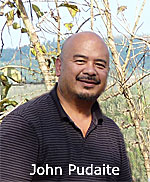 [Update by John Pudaite] When we got into Saiphai, we tried to convince the local road construction crew to allow us to use their backhoe excavator, and despite a lot of cajoling, we could not convince them to let us use it, even for a few hours.
[Update by John Pudaite] When we got into Saiphai, we tried to convince the local road construction crew to allow us to use their backhoe excavator, and despite a lot of cajoling, we could not convince them to let us use it, even for a few hours.
David, our Construction Supervisor, had been out on the site a day ahead of me, and with the Headmaster, John Milton Pulamte, had done some preliminary clearing, clean up and measurements on the plateau site for the academic building. We reviewed those, but decided we needed to be out first thing in the morning, to review and modify the alignment.
As darkness set in, we began calling contacts in nearby towns, searching for a backhoe to help us dig out the approach road, and finally got one that agreed to be there the next day.
Clearing the site
[Update by John Pudaite] Out to the site very early, crack of dawn, and started measuring and running lines around the site, trying to find the ideal alignment for the bulding. Unfortunately, the top of the plateau was far from square, and we just couldn't make the building, as drawn, fit on the plateau. We took a break for breakfast, and after confirming the backhoe was on its way, tried to draw possible alignments, or (gasp!) modifications to the building plan, based on the actual measurements.
Back out to the site in the early afternoon for the Big All-School Work Day on the site. All the students from Class 4 up came out to the site after finishing their 1st semester exam in the morning, to help in clearing and preparing the site for the excavation and layout work.

Headmaster John Milton Pulamte commanding his troops.
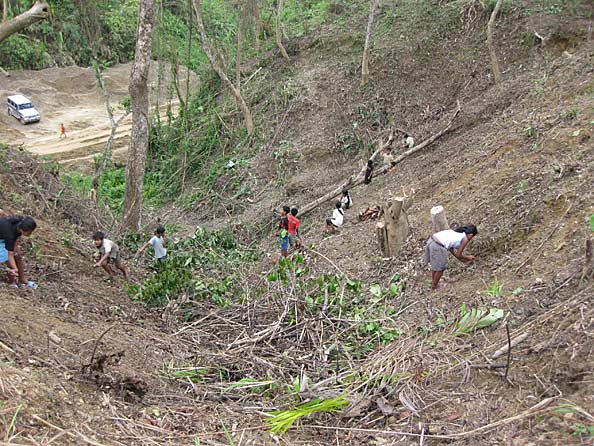
Students at work.

Students clearing the tall grasses.
Of course, a work day like this always calls for some rest - and some play.

Kids resting on Leaning Tree

Boys playing bamboo tug-of-war
The site cleared and ready to finalize the layout work, or so we thought.
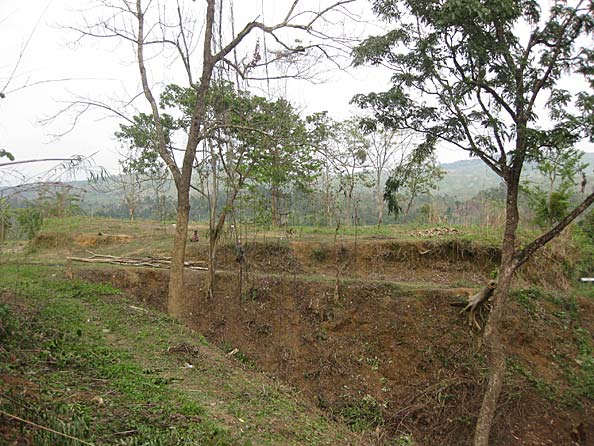
Academic building site.
The backhoe, which was to arrive by noon, finally showed up at around 4:30pm, and began the work immediately. We were able to quickly regain a decent access to the property, at least enough for the backhoe to climb up, and then were able to quickly carve out the new approach road, which winds along the eastern edge of the property, and then curves up the back (along the fruit trees), coming out at the front corner of the plateau (NW corner). We worked past dark, but were able to get the road roughed out. Pics of this work follow.

Backhoe opening up the approach road.
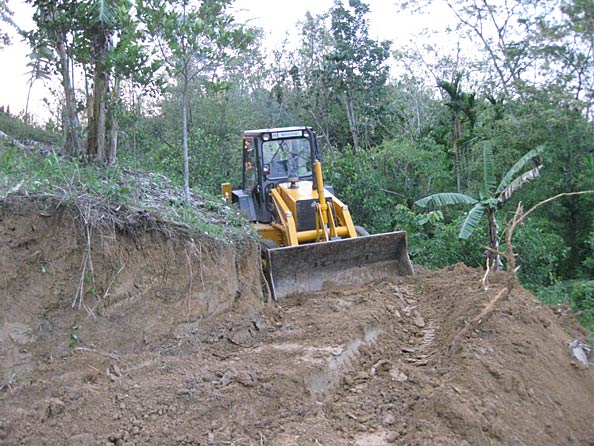
Backhoe working its way around the eastern boundary.
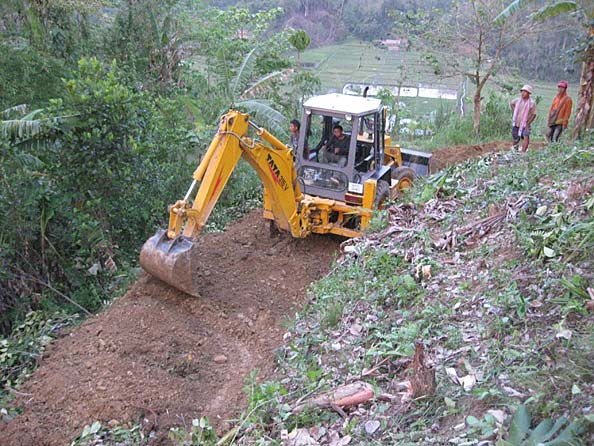
Backhoe cutting the access road through the fruit tree plantation.

Backhoe cutting, construction supervisor, David upper right. The slope was cleared by kids on work day.

Getting kind of dark out here, but almost done!
Throughout the afternoon/evening the backhoe driver kept complaining that his machine was not working properly. As we'd waited for him so long, we just kept egging him on, so that he'd at least get the road roughed out up to the plateau. When we got back to John Milton's home for dinner, the driver explained that the 4-wheel drive was not working on the machine, and that's why it was so hard to get the work done quickly. He said that the best thing was for him to head out the next morning early, get up to Aizawl, get the part, and come back down. Then we could resume the work effectively and efficiently.
That evening we continued to try to re-work the alignment and drawings, and finally, we came to the conclusion that, rather than changing the school layout, or having it perched precariously over one side or the other, we should . . . completely level the plateau. We asked the backhoe driver how long he thought it would take him to do this, and he said about 40 hrs. of work, plus or minus. Since he wouldn't be able to push the dirt over the eastern side, it all had to be brought back to the deep ravine, so it would take longer than we might expect.
After determining that this might cost us about $1,500, but then weighing the benefits of not having to modify (reduce) the building, and the additional area in front for student line-up, play area for recess, etc., we decided to go for it. So, with that decision firm, we turned in for the night. The driver left early the next morning to get the 4WD part.
Coordinating materials and prep work
[Update by John Pudaite] John Milton, David and I spent the morning visiting various construction materials and hardware shops in the town of Bhaga, across the Assam border, and found a surprisingly trustworthy cement and iron dealer who we will use as our primary supplier. Rather refreshing to find someone like them in such a short time. We continued on into the city of Silchar to take care of some additional business, and while there, came to find out that the backhoe driver would probably not be back to the worksite till late Monday. At that point, having some other pressing work in New Delhi, I decided to split off from John M. and David, and head out by road to Gauhati, and fly on to Delhi. John M. and David returned to the Saiphai, to continue the prep work.
A rollover can't stop John!
[Update by John Pudaite] I had a harrowing accident entering Gauhati, where my hired vehicle flipped over, trying to avoid a boy who had run out in the highway. Fortunately the boy only hit his elbow on the side mirror, and my driver had a few small cuts on his arm. I was fine, except for a jammed ankle, and a little chest pain from the seat belt. Anyway, got to the airport for my 8am flight, and on to Delhi.
Retention Pond - Being productive while the backhoe is getting fixed!
[Update by John Pudaite] Last but not least, while waiting for the backhoe driver to return and the machine to be repaired, David, our Construction Supervisor, and one never known to sit idle, spent a couple days developing the water supply source for the school. They cleared out the source, made an intake point, and then made a small retention pond in the ravine, creating the lower embankment with the hand-excavated dirt.

David (upper left) supervising the retention pond construction. Water flowing down into the pond can be seen, and embankment in foreground. This retention pond will serve the site during the construction period, but will be more properly developed for the actual school with, as Jethro Clampett used to say, a "cement pond".
The prep work is complete!
[Update by John Pudaite] Updates from the last week of work. Backhoe driver didn't get back on Monday, arrived on Tuesday. Tried to fit the part; found out it was the wrong one. Back to Aizawl city; got the right part, back to Saiphai. Finally resumed the work on May 10. Finished it all up by Saturday the 12th, using less hours than originally projected. Total cost, a little over $1,000.
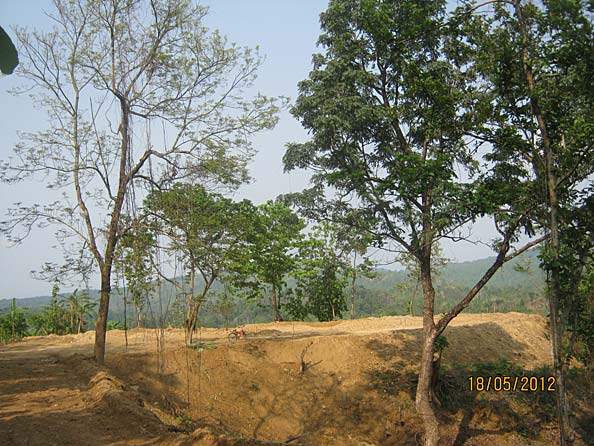
COMPLETELY LEVELED OFF PLATEAU, SITE FOR THE ACADEMIC BUILDING! (Note the progress from the previous building site pic, how much was taken down, and how the old approach road around the "front" has been completely leveled, giving us a lot more space in front.)
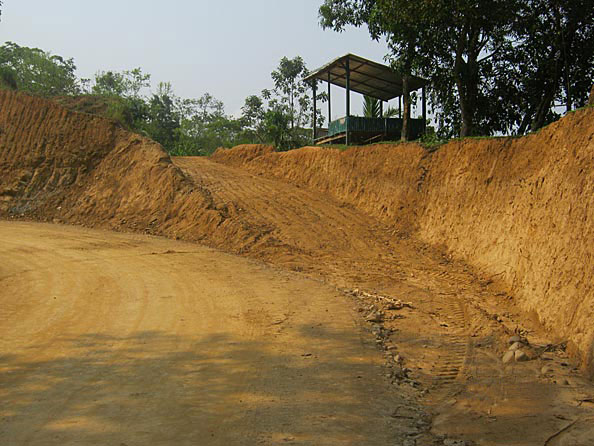
The new approach road, entering from the "highway".

Approach road along eastern boundary. We were fortunate not to damage the private "plantation" to the right.
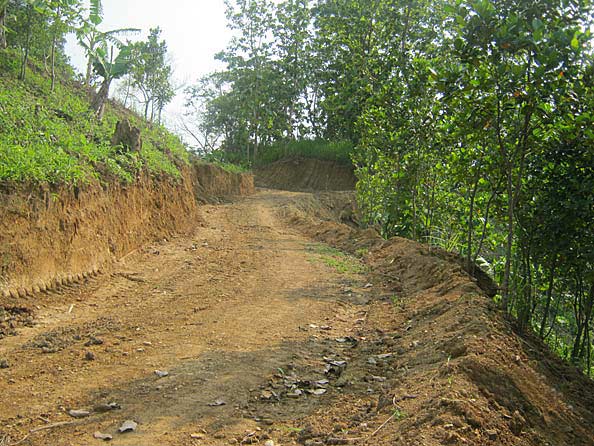
Approach road winding around the back, through the fruit trees.

Showing relative levels of approach road and levelled building site.

The leaning tree.

Site with stakes marking post layout.

Site with stakes marking posts. Notice the large front area on the right of the pic. Taken facing straight south.

Postholes being dug manually. Pic taken facing north by northeast.
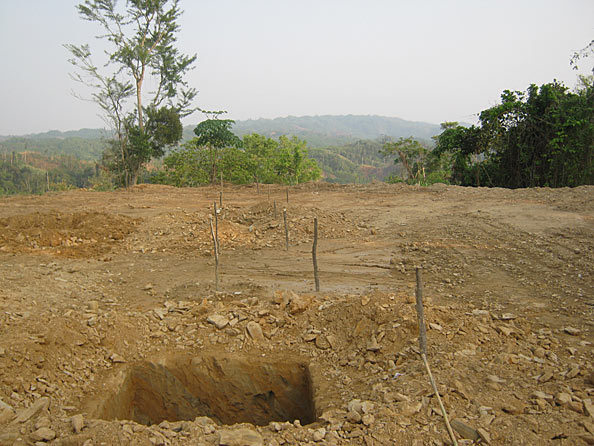
Postholes being dug manually. Pic taken facing straight south.
The backhoe was able to not only level the Academic Building site, but also had enough time to widen the "chicken neck" connecting to the other side of the property, reserved for residential (dormitories, staff quarters, etc.)
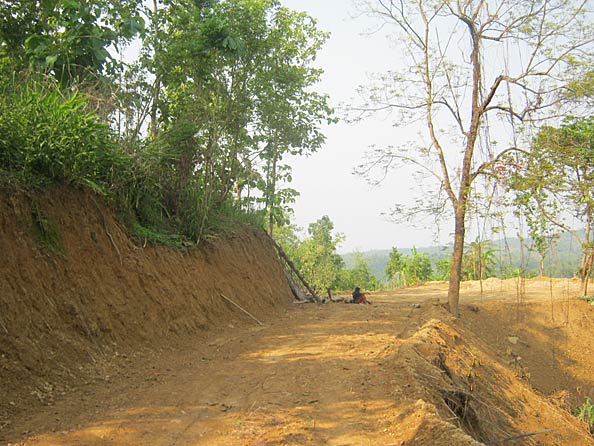
The "chicken neck" is now at least a goat's neck.
The site for the auditorium is to the left in this pic, and will also need to be leveled off later. But . . . that is Phase III or IV, as I recall. The widened chicken neck will now allow us to move vehicles in and out, turn around, have areas for staging and stocking of materials, etc.
Electricity is being brought to the site; the application has been made to the department through the Village Authority, so we expect a connection that will at least handle basic lighting, a water pump, hand tools, etc. to be there within the month. We will, of course, be supplying the wire, posts, cross-bars, etc. to make the connection. The department will only give us the permission.
I talked with David a few hours ago, and all the post holes of the main building (not including the 2 short wings), all 42 or so, have been dug. He was headed up through Aizawl to the remote village of Suongpuilawn, where he's giving a training seminar on "Cement Stabilized Compressed Earth Block" technology, something that we have pioneered in the Northeast. The equipment comes from the Indian agent of a South African company called Hydraform, and we use it in remote areas where fired brick is not available, or transport charges are too high.
The excavated soil at Saiphai would actually be quite ideal for Hydraform block-making, but bricks are available from the plains area toward Silchar at decent prices. We may look into using the technology for some of the miscellaneous buildings/structures, as it is Green technology, as the blocks are not burned/fired, but simply air-cured, thus reducing the deforestation and pollution resultant from burning bricks. We also don't have the lead time to get the Hydraform production rolling, if we want to get this building covered and walled in the next couple months.
Next steps are to prepare the reinforcement iron for the posts and the piers inside the postholes, and pour those. Materials for this step are on order, and should be delivered in the next day or two. Everything will be done on site. David will return by next Tuesday to resume supervision of the work.
![]()
![]()

